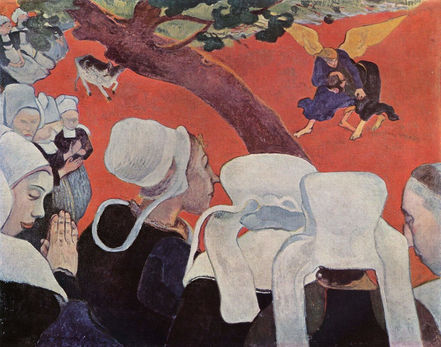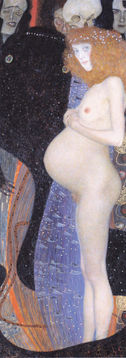
Symbols, colors and brushstrokes
NEO-IMPRESSIONISM
Georges’ Seurat’s artwork ‘A Sunday Afternoon on the Island of La Grande Jatte’ exhibited at the Societe des Artistes Independants in Paris marked a birth of a new art movement, named by Felix Feneon in 1886 ‘Neo-impressionism’. Neo-Impressionist artists found their interest in depiction of seashores and landscapes. Their constant search for new techniques and Seurat’s work with with French chemists led to a discovery of a new method of paint application. Instead of mixing colors on a palette or canvas directly, the technique assumed placing tiny brushstrokes of paint near each other. The technique received a name ‘separation of color’ or ‘Divisionism’ and helped to enhance vibrancy of the color. Such a technique creates an ‘optical mixture’ when perceived from a certain distance.


Divisionism became a prominent Neo-Impressionist style, developing alongside Pointillism (a term coined by art critics in late 1880's to ridicule works of pointilist artists). While Divisionism suggested application in more like cube-shaped brushstrokes, Pointilism supposed applying paint in dots.
Among with Georges Seurat, prominent Neo-Impressionist artists included Paul Signac (founder of Pointillism alongside Seurat), Camille Pissaro and Henri-Edmond Cross.


CLOISSONISM
Cloissonism is a style of Post-Impressionist painting defined by bold and flat forms with dark contours. It was developed by Emile Bernard and Louis Anquetin in late 1880’s. Cloissonism takes it’s inspiration from manner of medieval cloissone enameling of stained glass. In such technique, the wires (cloisons) are soldered to the body of the piece, filled with colored glass and then fired. The term cloissonism was first coined by the art critic Edouard Dujardin in 1888. Being one of the most influential styles of Post-Impressionism movement, it received less recognition.


Distinctive characteristic of Cloissonism became use of pure color in large shapescreating a two-dimensional appearance. Such style of painting was a result of constant Impressionist’s search for different methods of depiction of light by moving away from naturalist focus. Painters were combining aristic idea with subject, creating a more powerful form of modern art. Cloisonnism is associated with the Pont-Aven artist colony in Brittany, whose members included the expressionist painters Jacob Meyer de Haan, Charles Laval, Charles Filiger, Armand Seguin, and Paul Serusier whose painting The Talisman (1888, Musee d'Orsay) had a major impact on the aesthetics of the Nabis group.
LES NABIS
Les Nabis (French pronunciation: [le nabi]) was a group of young French artists active in Paris from 1888 until 1900, who played a large part in the transition from impressionism and academic art to abstract art, symbolism and the other early movements of modernism.

The members included Pierre Bonnard, Maurice Denis, Paul Ranson, Édouard Vuillard, Ker-Xavier Roussel, Félix Vallotton, and Paul Sérusier. Most were students at the Académie Julian in Paris in the late 1880s. The artists shared a common admiration for Paul Gauguin and Paul Cézanne and a determination to renew the art of painting, but varied greatly in their individual styles. They believed that a work of art was not a depiction of nature, but a synthesis of metaphors and symbols created by the artist. In 1900, the artists held their final exhibit, and went their separate ways.
SYNTHETISM
Synthetism is a term used by post-Impressionist artists like Paul Gauguin, Émile Bernard and Louis Anquetin to distinguish their work from Impressionism. Earlier, Synthetism has been connected to the term Cloisonnism, and later to Symbolism. The term is derived from the French verb synthétiser (to synthesize or to combine so as to form a new, complex product). S


Synthetist artists aimed to synthesize three features: the outward appearance of natural forms, the artist's feelings about their subject, the purity of the aesthetic considerations of line, colour and form. In 1890, Maurice Denis summarized the goals for synthetism as, 'it is well to remember that a picture... is essentially a flat surface covered with colours assembled in a certain order. The term was first used in 1877 to distinguish between scientific and naturalistic impressionism, and in 1889 when Gauguin and Emile Schuffenecker organized an Exposition de peintures du groupe impressioniste et synthétiste in the Café Volpini at the Exposition Universelle in Paris. The confusing title has been mistakenly associated with impressionism. Synthetism emphasized two-dimensional flat patterns, thus differing from impressionist art and theory.
SYMBOLISM
Symbolism was a late nineteenth-century art movement of French, Russian and Belgian origin in poetry and other arts. The term "symbolist" was first applied by the critic Jean Moréas, who invented the term to distinguish the Symbolists from the related Decadents of literature and of art.


There were several rather dissimilar groups of Symbolist painters and visual artists, which included Gustave Moreau, Gustav Klimt, Odilon Redon, Pierre Puvis de Chavannes, Henri Fantin-Latour, Gaston Bussière, Edvard Munch. Symbolism in painting was even more widespread geographically than symbolism in poetry, affecting Mikhail Vrubel, Nicholas Roerich, Victor Borisov-Musatov, Martiros Saryan, Mikhail Nesterov, Léon Bakst, Elena Gorokhova in Russia, as well as Frida Kahlo in Mexico, Elihu Vedder, Remedios Varo, Morris Graves and David Chetlahe Paladin in the United States. The symbolist painters used mythological and dream imagery. The symbols used by symbolism are not the familiar emblems of mainstream iconography but intensely personal, private, obscure and ambiguous references. More a philosophy than an actual style of art, symbolism in painting influenced the contemporary Art Nouveau style and Les Nabis



























